
Ming Trade Ceramics
During the early Ming period, private trades with foreigners were banned. The only permitted channel of trade with foreigners was through the tribute system. Severe punishment was meted out on those who infringed the law.
Thailand and Vietnam made use of the opportunity to fill the demand for porcelain wares. This was the golden period for ceramics from the two countries. Many Thai celadon and iron painted wares and Vietnamese blue and white of this period were excavated in Southeast Asia.
Based on findings in ancient habitation sites and shipwrecks in Southeast Asia, it is clear that some Chinese Ceramics, especially Jingdezhen blue and white and Longquan celadon continued to find their way to Southeast Asia despite the ban. By the late 15th Century Hongzhi period, significant amount of Chinese ceramics were smuggled out of the country. The Lena and Brunei wreck, both dated to Hongzhi period, provided a wealth of information of the type of Blue and white and Celadon exported. By this point of time, Jingdezhen Blue and white constituted the bulk of export Chinese Ceramics. Longquan celadon wares were exported in relatively small quantity. Most the the Longquan celadon vessels are heavily potted and decorated with carved floral design.

Ming Blue and white wares in Exhibition organised by Singapore Yinliuzhai Ceramics Society & Rao Bao Tang
The lure of great profits from trade in Chinese goods especially silk and ceramics attracted European adventurers to China. The European powers through their trading companies controlled the flow of goods between China and the West duirng the 16th to 19th century.
The Portuguese first arrived at Tunmen (near the mouth of the pearl river) in Guangdong in 1513. They had some initial success and made lucrative profits from the trading. When they could no longer conduct any business through Tunmen, they diverted there activities to Yuegang in 1522 where the imposition of trade ban was less stringent and effective. The persistent Portuguese finally succeeded in securing Macau as a permanent base for trading in 1557.
The Spaniards arrived in Philippines via America in 1521. Using Manila as a transhipment point, goods from China, India and Southeast Asia were assembled and loaded on the galleons which made regular voyages to Acapulco in Mexico, another Colony of Spain. The Spaniards paid for the goods and taxes with silver from Mexico and Peru. The peak period of trade was between late 16th century to mid 17th century.
The Dutch was a relative late participant in the spices and ceramics trade. They started out looking for the riches of the East in 1602. In the ceramics trade, they lost out to the Portuguese and Spaniards who already established good connections and networks. They only managed to gain official permission to trade through Farmosa (Taiwan) in 1624. In order to dominate the maritime trade, they repeatedly attacked and looted the ships of the Portuguese/Spaniards and junks of the Chinese. They were feared and notorious for their atrocities. The destructive ravages and the disruptions to trade of the Dutch was one of the factors which subsequently contributed to the decline of Yuegang. The Dutch finally dominated the maritime trade in the first half of the 17th century.
The Ming court finally realised the futility and difficulties of imposing the trade ban. By legalising and officially recognising Yuegang as a port for foreign trade in 1567 A.D, it hoped to curb corruption and smuggling activities. The revenue generated from tax on foreign trade would also help to maintain the army to fend off the pirates, especially those from Japan. Yuegang benefited from the new policy and became an important international port of the late Ming period.
By Wanli Period, a new type of Blue and white termed kraak porcelains based on European design requirements were exported in large quantity to Europe. It is typified by motif organised in panelled form. Blue and white vessels decorated in motifs similar to those found locally continued to be exported to Southeast Asia region.

Ming Blue and white wares in Exhibition organised by Singapore Yinliuzhai Ceramics Society & Rao Bao Tang
Overseas demand for blue and white was great during the late Ming period. Jingdezhen by itself was unable to meet the demand of the overseas customers. Many kilns located near the coastal ports in China also capitalised on the market demand and produced blue and white. The most important centre was located in Zhangzhou which produced blue and white and overglaze enameled wares which was termed Swatow wares. Swatow wares are more thickly potted and usually have grits on the outer base.
Dehua rose to prominent during the late Ming period. It exported a large varieties of wares commonly termed Blanc de chine: cups, censers, gu-vases, ewers, bowls, large plates, lamp, seated lions, figurines. Blanc de chine wares have a silky ivory white tone and the porcelain is translucent.
Jingdezhen Folk Kiln Blue and white Wares
During the early Ming period, the court imposed a relatively high degree of control on political and cultural development. Such restrictions significantly impacted the type of decorations found on folk kiln blue and white wares. As a result, only a relatively limited range of motifs were available. Usually the motifs are highly stylised and simplified and executed in calligraphic style. It was dictated by economic considerations as such mode of production facilitated quick execution and increased production volume. The calligraphic lines of the motif is spontaneous and highly rhythmic. This carefree style without depiction of details has a charm and character of its own. During the early Ming period, the typical motifs depicted included: interlacing floral scroll with Sanskrit character , rolling clouds, 3 friends of winter (represented by pine, plum and bamboo), ornamental balls with silk knots, characters fu (福) (fortune) and shou (寿) (longevity), rolling clouds with human figures which resemble dreamland and hermit in countryside setting. The influence of Tibetan Buddhism is shown in elements such as Sanskrit/Tibetan characters and Buddhist 8 precious objects (conch shell, wheel, umbrella, canopy, lotus, vase, fish, endless knot).
|
|
| Interlacing floral scrolls with Sanskrit characters. It shows typical calligraphic style of execution of the motif |

rolling clouds with human figures
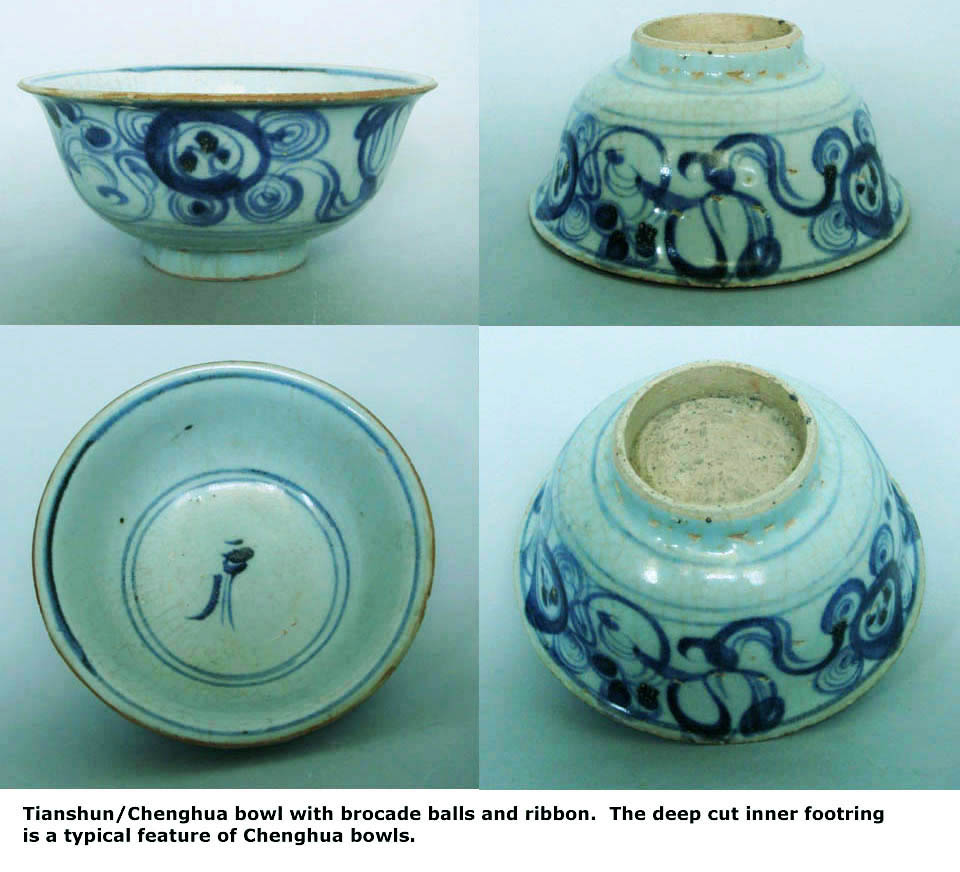
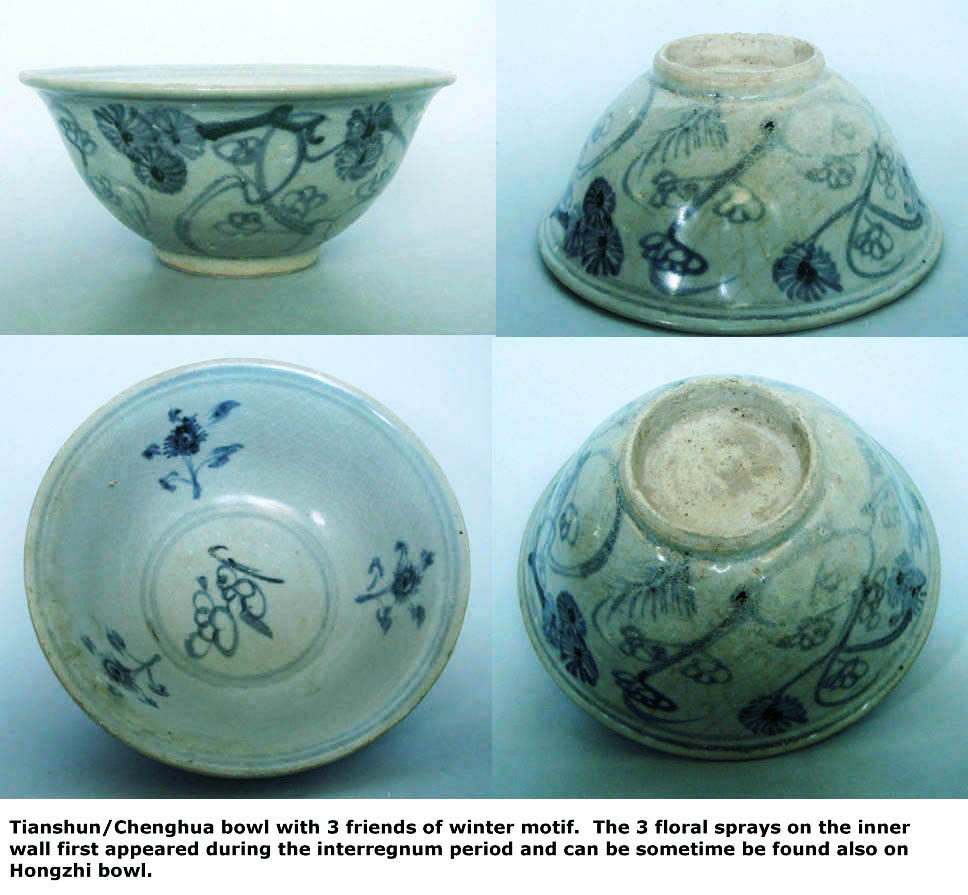
Majority of the wares produced during the Early Ming period were functional in nature, such as bowl, plate, covered jar and incense burner. Vases only constituted a small quantity of the production.
So far, shipwrecks, such as Pandanan and the Royal Nanhai wreck in South China sea, which are dated to Interregnum period carried only small quantity of Chinese ceramics. However by the Hongzhi period, a thriving illegal private trade has developed. The Hongzhi period Lina cargo is clear reflection of the situation. It carried a relatively large quantity of good quality blue and white wares. Another contributing factor which prompted this development was the situation during the Hongzhi period.
During the reign of Chenghua, the imperial kiln produced large quantity of porcelains as can be seen from the excavations in Jingdezhen. When Hongzhi took over, he recognised that it was a big drain on the state finance. He ordered imperial porcelain production to be drastically reduced. As a result, the redundant potters would have to find other means to support their livelihood. They turned to production of wares to meet oversea demand from illegal private trade.
The pigmented-wash method of decoration which was experimented most probably during the Tianshun period gained greater popularity and used on bulk of the blue and white wares from late Chenghua onward. The wash was applied over some part of the drawn motif such as the flower or dress of human figure. Generally you can distinguish two tonal blue in the wash area Most actually utilised a combination of calligraphic and pigmented-wash method to execute the motif. Those that utilised fully calligraphic style or with motif completely cover with pigment wash constitute a smaller portion of the production.
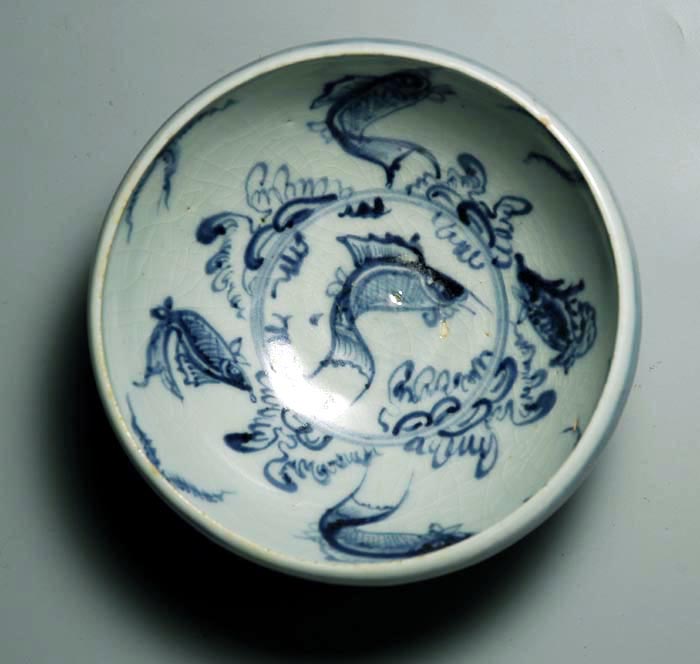 |
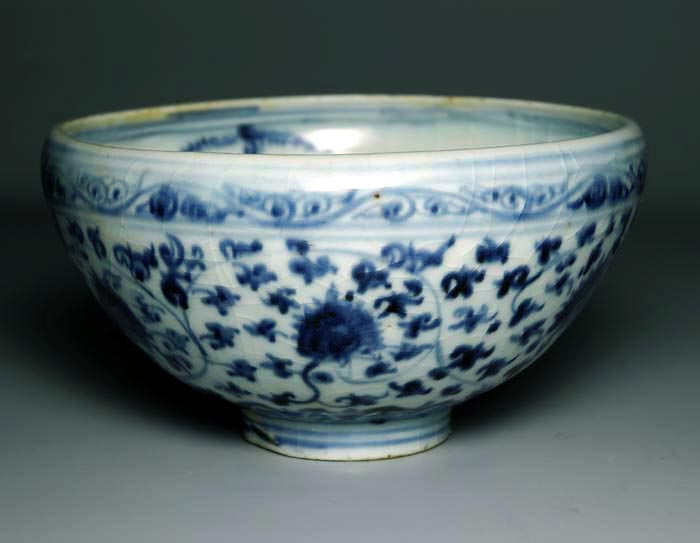 |
| Hongzhi warmer bowl | |
During the Zhengde period, some blue and white porcelains with Islamic influence such as Arabic scripts were produced. Some speculated that it was because emperor Zhengde was converted to Muslim faith. However, the more probable reason could be the influence of the powerful eunuchs , many of whom were Muslims.
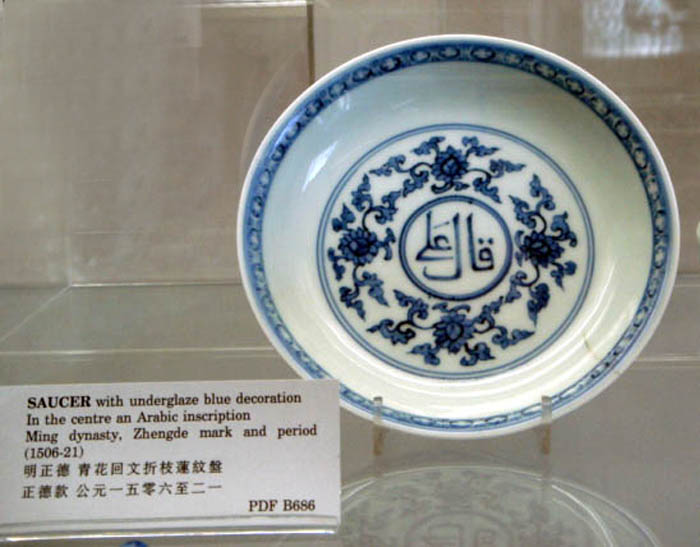
Ming Hongzhi period also witnessed a change in the design composition. Many bowls and plates have more densely and fully decorated inner wall. This is a rather unique phase as those before and after this period generally have plain or more sparsely decorated inner wall. The exception was the kraak style motifs of Wanli/Chongzhen period.
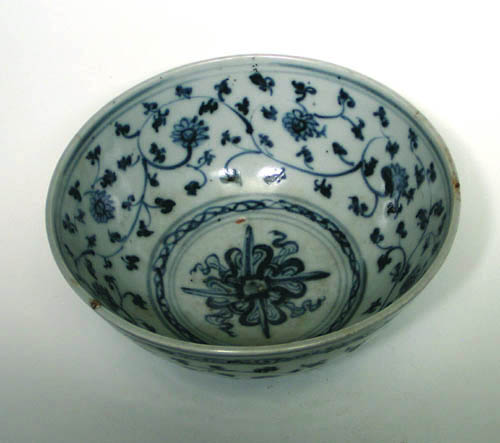 |
| More densely decorated interior of bowls and plates |
Mark such as "Fu (福)" , "Da Ming Nianzao (大明年造)", "Tian (天)" and "Tai ping (太平)" , on the outer base also appeared in wares during Chenghua/Hongzhi period.
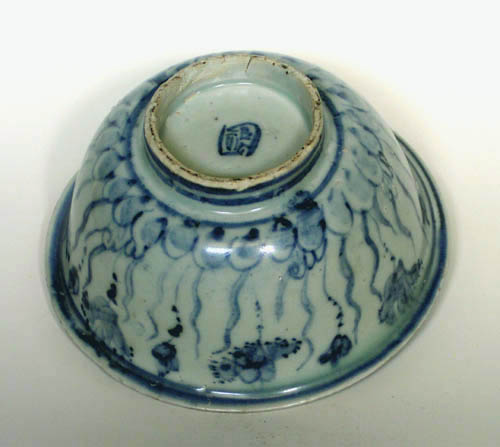
Bowl with fu mark on outer base
Officially the tribute system of foreign trade implemented since Hongwu period only came to an end in 1567 (Jiajing) with the opening of Yuegang (月港) in Fujian for legal foreign trade. Jiajing period heralded the implementation of the Guan da min shao (官搭民烧) system. Under this system, imperial porcelain production was contracted out to private kiln operators. The high quality requirement forced the potters to improve quality of their products. The penalty for failure to meet quantity and quality requirements was stiff. Besides paying a fine, they had to buy in pieces from the officials to meet any shortfall in government order.
Emperor Jiajing who succeeded Zhengde was a devout Taoist. Taoist symbolism became a common decorative element during the late Ming period. Taoist motifs such as the Eight immortals, eight Taoist Emblems, the Pakua (eight diagrams) , the cranes, auspicious character shou (often formed by twisted peach tree as above picture) were frequently depicted ont the vessels.
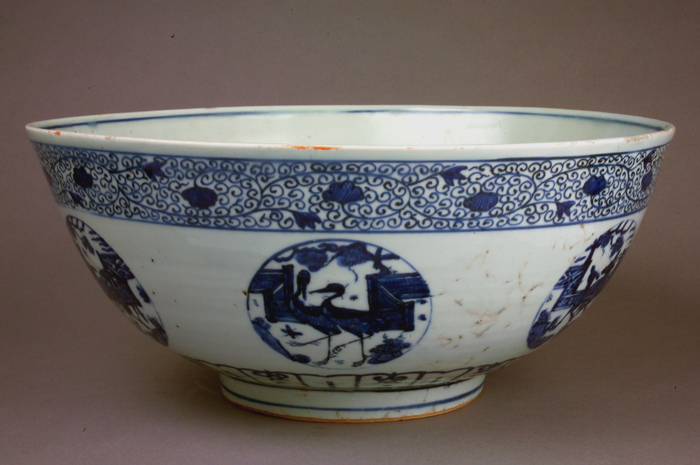 |
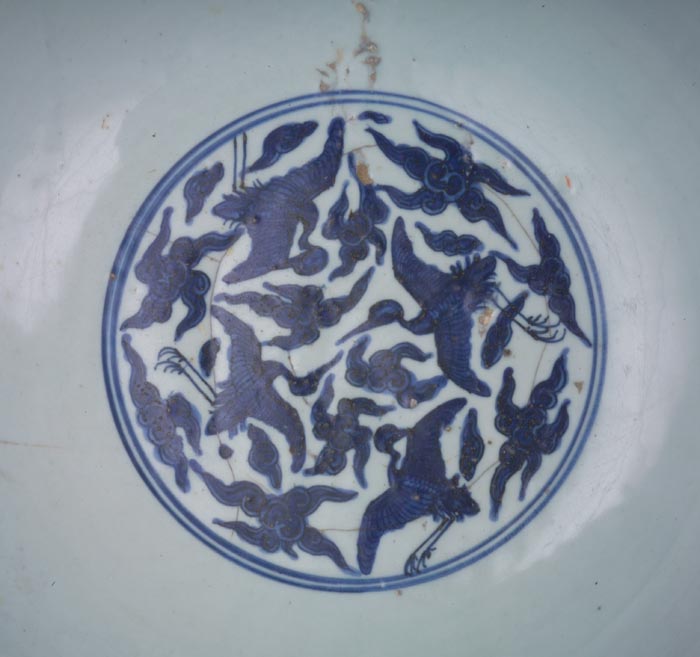 |
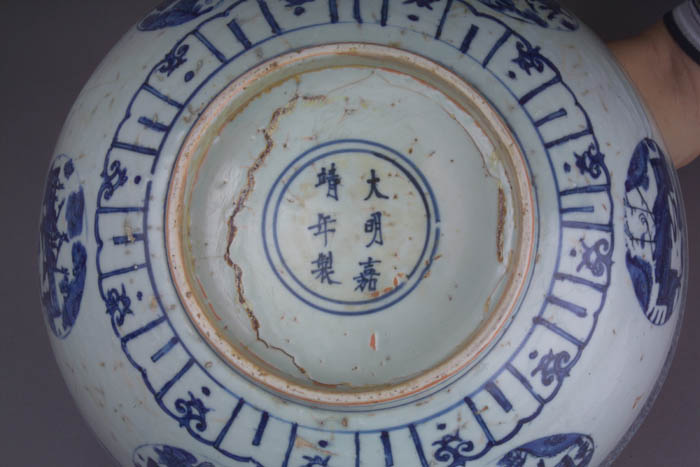 |
| Jiajing bowl with crane's and deer's motif. They are all Taoist symbols of longevity | |
An unique feature for Jiajing/wanli period is the use of Hui qing (回青), a form of imported cobalt which is purplish in colour tone. Hui qing needs to be mixed with local cobalt as too high an amount of it will conceal the details of the lines under the wash. A well proportioned mixture of hui-qing and local cobalt will create a brilliant clear purplish motif. From Jiajing onward, the outline and wash method became the mainstream style of decoration. The outline is thin and of even thickness, which the Chinese calls iron thread. The good quality pieces also have clear even one tone wash.
 |
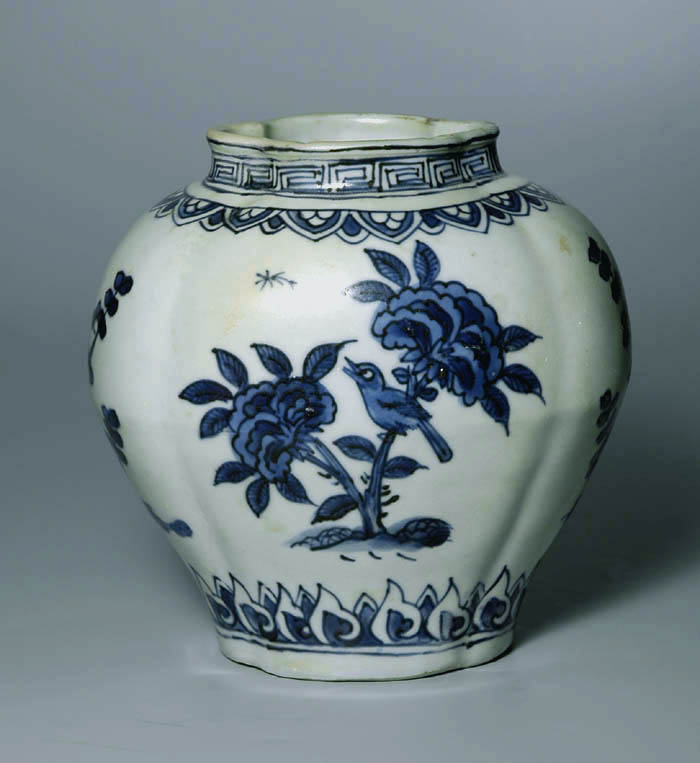 |
| Wanli bowl with infants motif | Jiajing/Wanli jar with bird/floral motif |
Many of the Jiajing/Tianqi bowls/plates also carried auspicious phrase consisting of 4 Chinese characters on the outer base. Some common phrases include Wan Fu you tong (万福攸同), Fu gui Jiaqing (富贵佳器), Chang Ming Fugui (长命富贵) and etc.

The Portuguese maritime explorers made their way to China around 1514. The high quality of the Chinese porcelains generated great interest and demand from the European elite class and the wares became a form of status symbol. Some of the earliest typical blue and white wares exported to Europe are similar to those found in the Fort Sebastian Wreck. A unique form of wares termed the kraak wares made to meet the specifications of European clients were produced from the Wanli period. Kraak derived from "carrack", a type of Portuguese ship captured by the Dutch in 1603 inside which carried a large quantities of these wares. The typical Kraak ware has a central theme on the inside of a bowl or plate and panelled motifs on the interior walls. The walls of the bowls and plates are generally thin. One common defect of the kraak wares is flaking of the glaze along the rim. The Japanese called it mushikui, i.e.. "insect nibbles". Some examples of Wanli kraak wares could be seen in the San Diego Shipwreck.
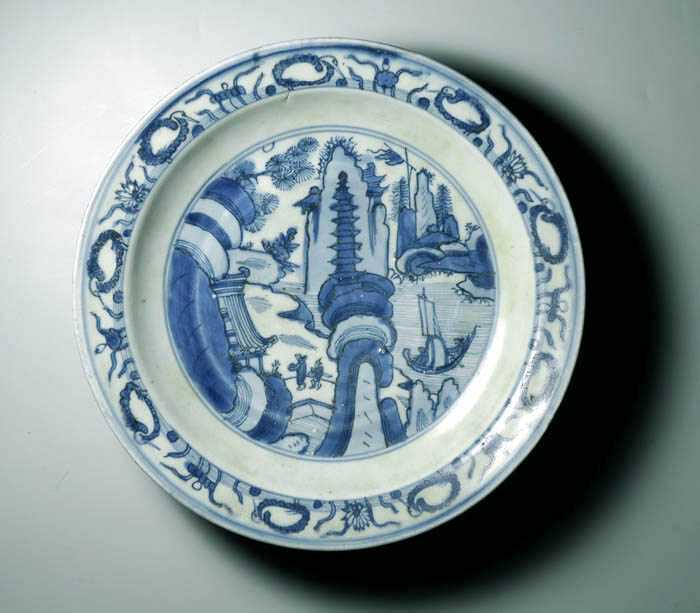
Jiajing/Wanli Kraak style plate
Wanli/Tianqi Kraak style plate from the Wanli wreck
During the Chongzhen period, a type of porcelain, commonly called transitional wares were produced. One common feature of these wares is the thick construction. The quality of the porcelain is comparable to those found on imperial wares. The glaze is excellent and the standard of blue and white painting is superb. The subjects covered are varied: including flowers, landscapes and scenes taken from Chinese plays or historical episodes. Many of the pieces also incorporated supplementary foreign decoration, such as the tulip. Also commonly found is a band of incised pattern near the rim of the ware such as incense burners, brush pots, and sleeve vases. The fish scale-like representation of grasses, the curling shaded clouds and mountains/stones with fine shadings were common features during Chongzhen period.
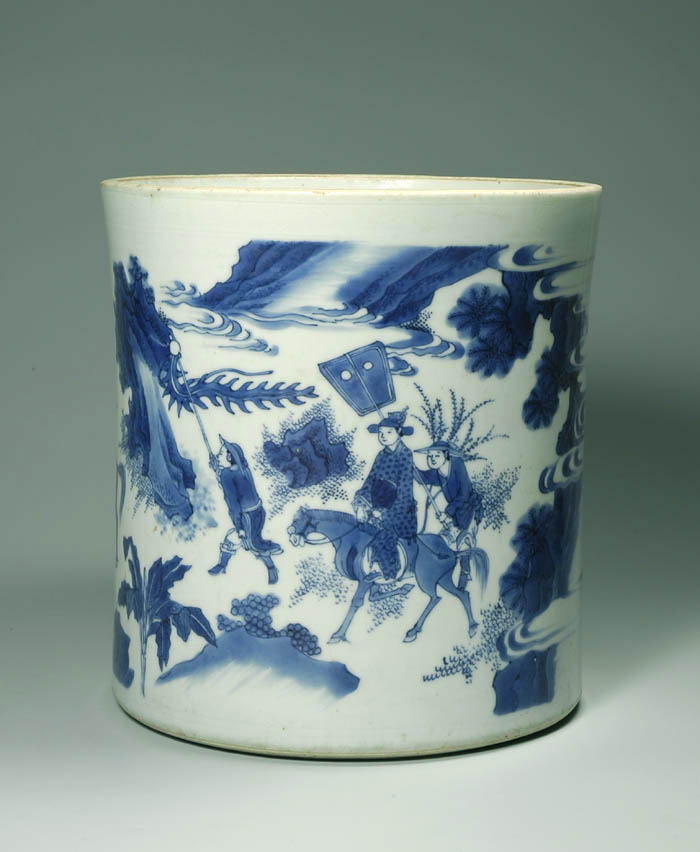
Chongzhen brush pot with fish scale grasses and fine shading of the rocks
Zhangzhou Blue and white/Enamelled wares
Swatow ware is a specialised group of chinese ceramics characterises by the sandy grits on the base, heavy /coarse potting. It attracts many collectors with its spontaneously executed decoration. It was termed swatow wares as it was erroneously believed to be exported from Swatow (shantou [汕头]) in Guangdong province.
|
|
|
A typical swatow (Zhangzhou) blue and white with grits adhering to the outer base
The arrival of the European (first the Portuguese, followed by the Spaniard and Dutch) created additional overseas markets. Yuegang in Zhangzhou was designated as a port for foreign trade in 1567 A.D. Due to constantly increase demand for ceramics, the Jingdezhen potters could no longer produced enough to meet the need of the overseas market. Zhangzhou, with its bountiful supply of raw materials for ceramics production and ease of transport by rivers, seized the opportunity and became an important production centre. The production volume was indeed huge as evidenced by the large number excavated from ancient habitation and burial sites, salvaged from shipwrecks and passed down as heirlooms in Southeast Asia countries and Japan. Their physical traces could also be found all the way to Africa and America. The fortune of the Zhangzhou kilns took a downward turn after the fall of the Ming Dynasty. Taiwan, which Zheng Cheng Gong captured from the Dutch, was the last base of Ming loyalists' resistance against the Qing rule. The final blow was dealt when Emperor Kangxi ordered the evacuation of all residents from the coastal region of Fujian and Guangdong in 1662 . The strategy was to cut off any coastal support for the resistant force in Taiwan. When the ban was lifted in 1682, Yuegang failed to recover its previous glory.
Shipwrecks provide wealth of information on the types of Zhangzhou wares being produced. The known wrecks include:
Those Zhangzhou type wares found in Hatcher cargo and Wanli cargo are small in quantity. The Zhangzhou type wares found in Vung Tau were even fewer, a confirmation of the decline of Zhangzhou kilns.
Generally speaking, there are the following 6 types of Zhangzhou wares: blue and white, blue and white with overglaze enameled motif, overglaze enameled motif, monochrome with underglaze white slip motif, monochrome with incised motif and lead glaze sancai.
Mrs Sumarah Adhyatman in her book "Zhangzhou (Swatow Ceramics)" chronologically classified Zhangzhou blue and white based on the stylistic execution of the decoration. She identified those executed using calligraphic strokes as "Conservative type" and the later kraak style type using the outline and wash method as the "persistent type". She is of the view that the conservative type were introduced earlier than the persistent type. The discovery of the San Isidro and Nan Ao wrecks provide evidence to support her view. The Zhangzhou wares in the two wrecks also confirmed that at least by Ming JiajingEarly Wanli period, such wares were already in production. Generally the earlier Zhangzhou plates, besides the calligraphic style of execution of the decoration, also have a cleaner outer base with less sign of grits adhesion.
|
|
|
| Zhangzhou blue and white from the Nan Ao shipwreck with motif executed in calligraphic strokes | |
|
|
|
|
|
|
| Two examples with motif executed in calligraphic strokes | |
|
|
|
|
Zhangzhou blue and white (the persistent type) using the outline and wash method |
|
 |
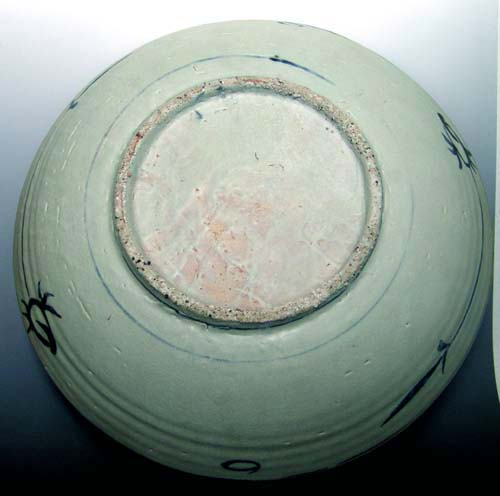 |
|
Binh Thuan wreck Zhangzhou kraak style large charger |
|
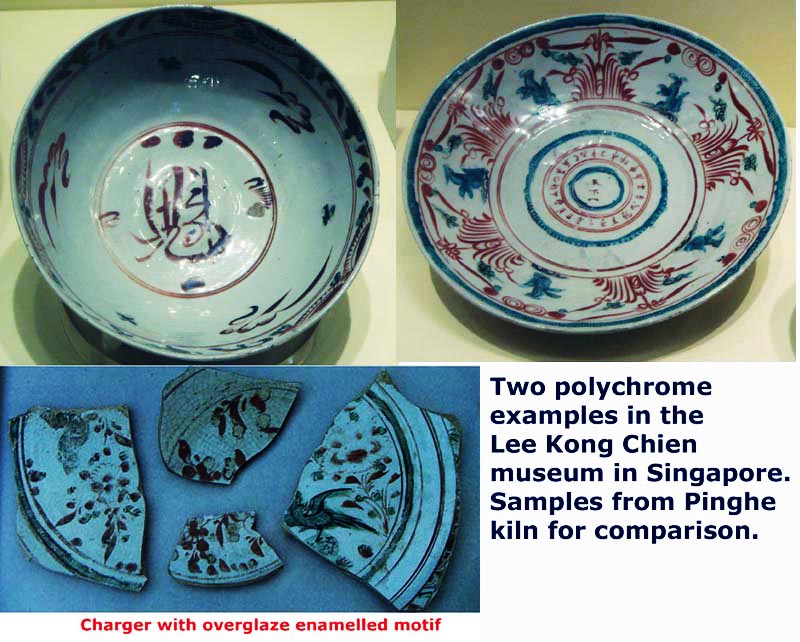
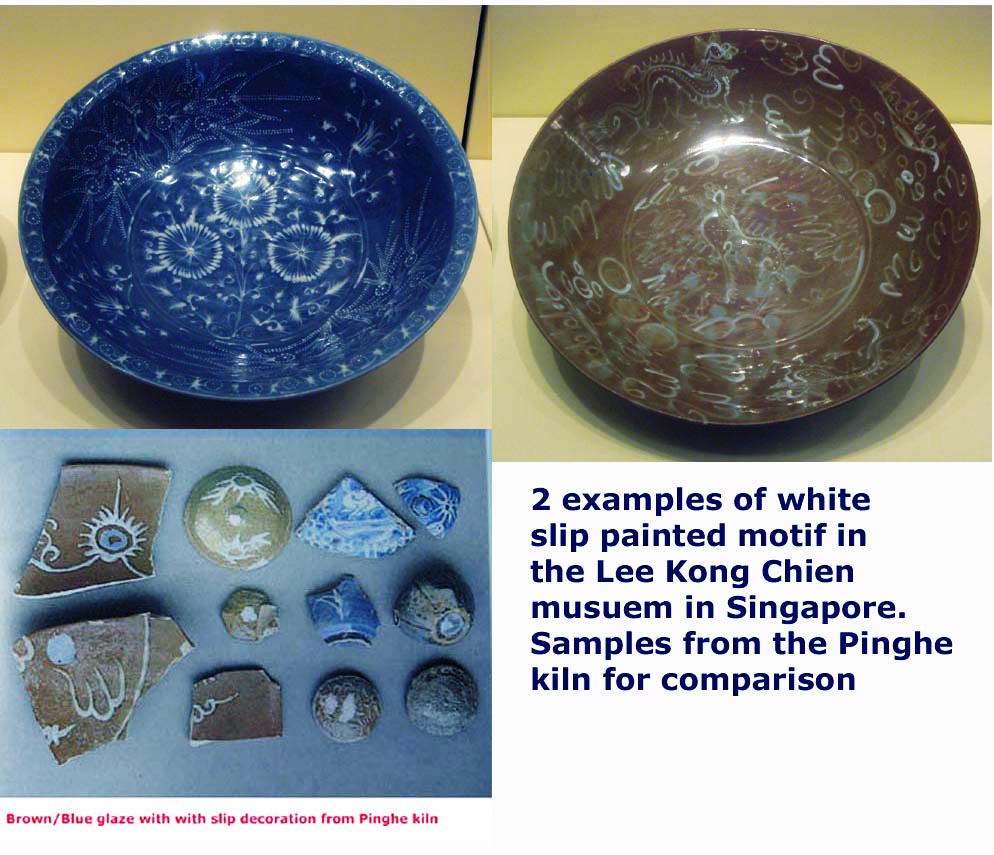
to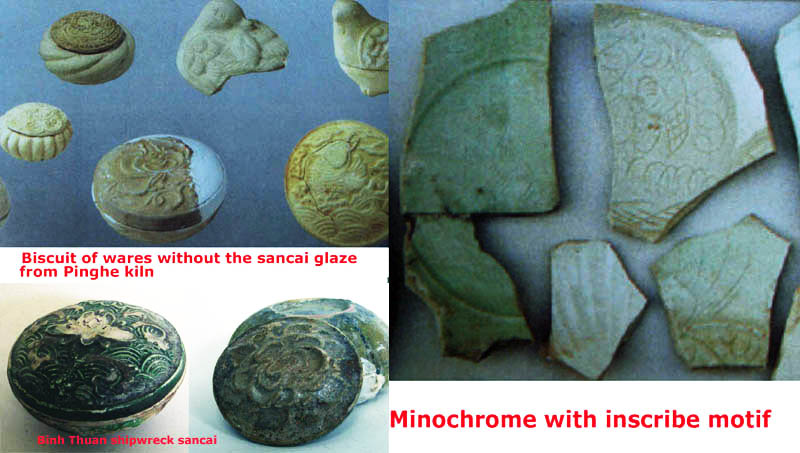
Dehua Banc de Chine
Dehua potters introduced the blanc de chine wares during the 16th century firstly mainly for the Southeast Asian market. During the 17th/18th century, many Dehua blanc de chine were exported to Europe. Dehua ivory colour tone blanc de chine received considerable favouable responses in Europe and were widely collected by royal families and nobles.
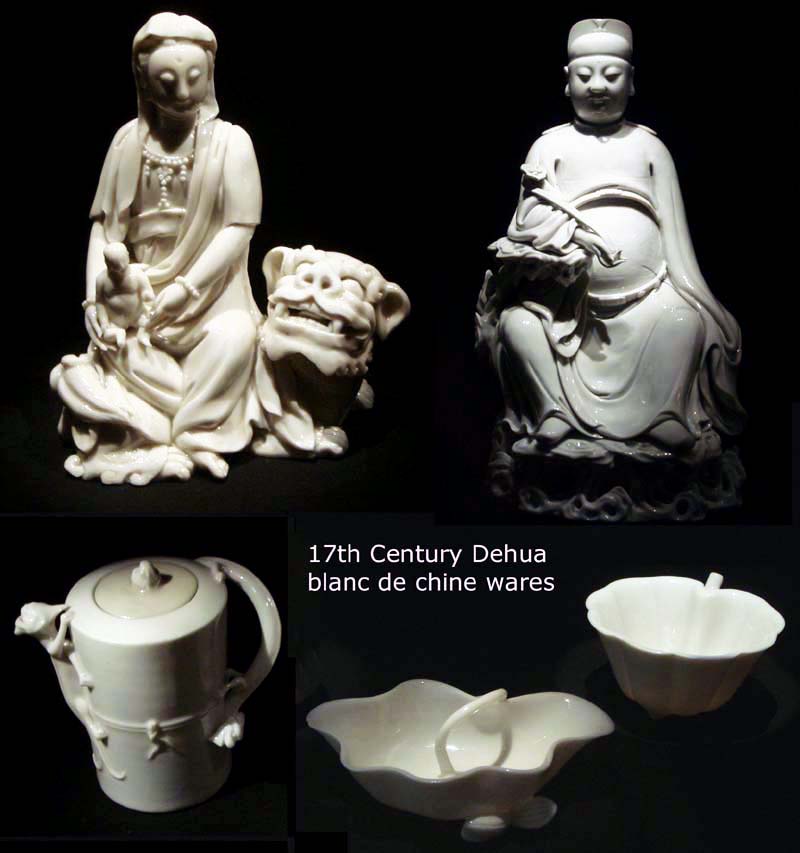
Longquan celadon wares
Longquan celadon wares which was one of the most important export porcelains during the Song/Yuan period continued to be produced but on a much reduced scale. The imposition of foreign trade ban during the Hongwu period was a severe blow and may have been a key factor contributing to the decline of Longquan kilns. Despite the trade ban, during the early/mid Ming period, some porcelains were smuggled overseas. By Ming Hongzhi period, only a relatively small quantity of Longquan celadon was exported. This is evident in the shipwreck Lenga cargo found in the Palawan straits in Philippines. The cargo constituted mainly of Jingdezhen blue and white. Only a small numbers of Longquan celadon wares, mainly big plates and jarlets were among the finds.
From the Turiang and Longquan shipwrecks dated to the Hongwu/Yongle period, those big plates with impressed central motif on the interior base and indent vertical strips, appeared to be the main types being exported.
|
|
|
|
Ming example with carved instead of the impressed central floral motif |
|
By the time of the Lena wreck dated to Ming Hongzhi period, those with carved flowers/floral scrolls such as the below plate constitutes a significant part of the overseas cargo of big Longquan plates. It is likely that such types were mainly produced during the Mid to Late 15th century. There were few plates with the impressed central floral motif and vertical strips on inner wall.
For those with elaborate decoration, both the inner and outer surface of the plates/bowls are decorated with carved floral motif. In fact, the carved floral scrolls are very similar to those found on the Ming blue and white plates/bowls of the period.
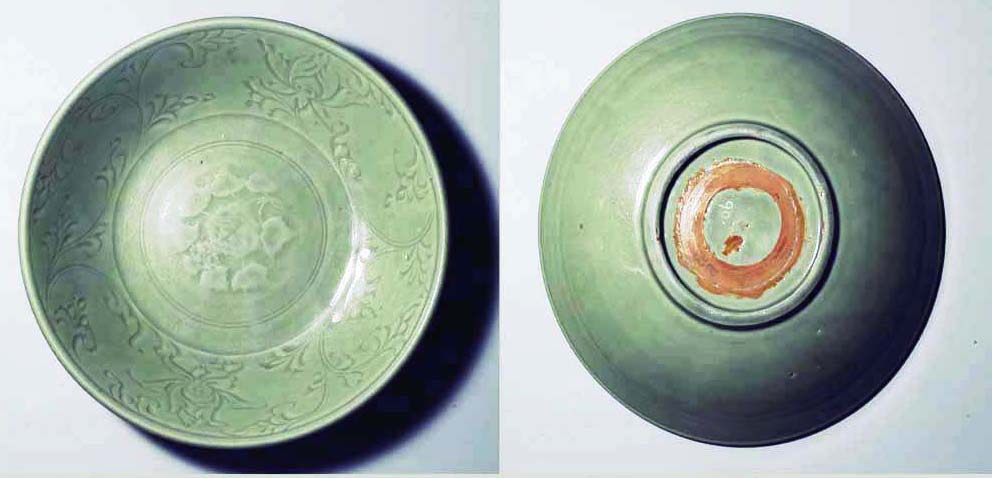
Mid Ming celadon plate with carved and impressed floral motif. Similar examples were found in Lena Cargo
Besides the distinctive carved floral motif, Ming Longquan shared some other common features. They are typically more thickly potted, heavy and high fired as compared with those of the Yuan period. When strikes with the finger, many pieces have a high ring tone. As for the glaze, many are light greyish green or grass green in colour tone. The foot of the bowls are usually thicker than those dated to Yuan period.
|
|
|
|
|
|
|
Two 15th Century Ming bowls, let one with carved and the other impressed floral motif |
|
|
|
| Some of the bowls and plates are impressed with surname of the kiln operators. The plate on the left has the impressed Gu Shi (顾氏) and the other Gu mark. A similar plate to that on the left was found in the Lena Cargo. Gu shi Cheng (顾仕成) was a famous kiln operator from Dayao during the Mid Ming period. Those with the Gu mark may be related to products produced in kilns operated by his family. | |
 |
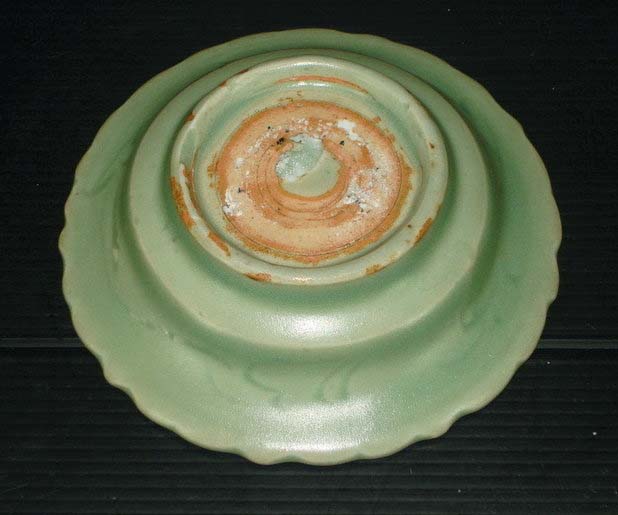 |
|
Such dish with floral shaped rim was a product popular during the Mid Ming period |
|
|
|
| A new type of bowl with slender chrysanthemum-like petals also made its appearance during the Mid Ming period. Similar bowls were recovered from the Lena cargo. |
By late Ming Jiajing period, Longquan wares were seldom found in the overseas markets. Blue and white wares from Jingdezhen became the dominant products. A survey of the kilns in Longquan also showed that by Mid Ming period, the number of kilns in operation were small in number (less than 20% the number during Yuan period). Ban on oversea trade (except through official tributary channel) imposed during the Hongwu period essentially cut off overseas demand and many kilns were forced to close down. After the lifting of ban on overseas trade during the Ming Longqing period, Longquan wares failed to recapture the overseas market. Production scale further dwindled and the quality of the products deteriorated further.
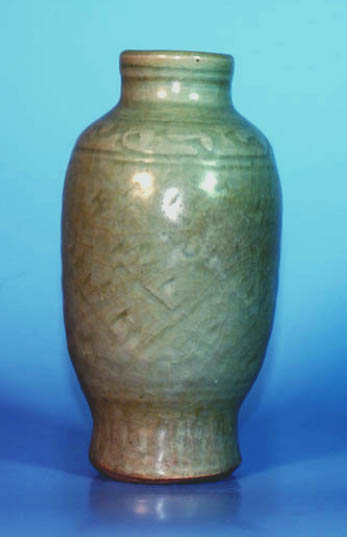 |
| 16th Century Ming vase. The carved diaper decoration is distinctive of this period |
Go to : Qing Trade Ceramics Return to: Tang/5 Dynasties Trade ceramics Song Trade Ceramics